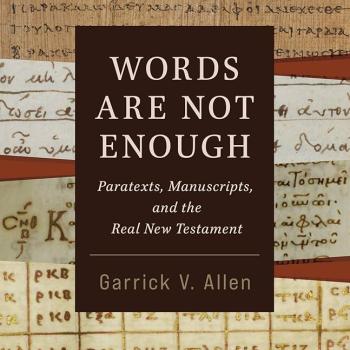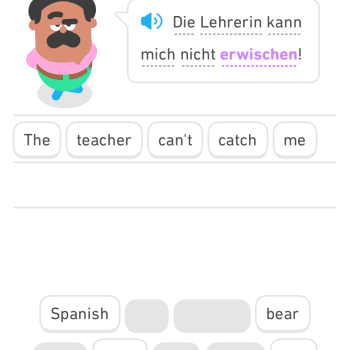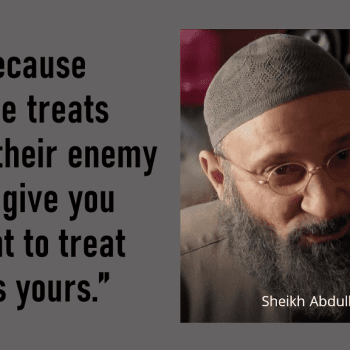I mentioned on Facebook that I have been thinking about other possible ways of structuring my course on the Bible that I teach pretty much every semester at Butler University. Here’s what I wrote:
Question for biblical studies educators (as well as students and others who might have a relevant and interesting perspective to offer on this):
I’m dissatisfied by the structure of my one-semester course on the Bible and pondering how to change it. This is a course that most students take because it counts towards a humanities-type requirement in our university core curriculum, and so there is a mix of religious backgrounds, degrees of interest, and prior knowledge. I currently have a structure based largely on canonical order. I’m thinking of trying jumping around more, perhaps going straight from a few days on Genesis 1-3 to a few days on the infancy stories in Matthew and Luke, under a heading like “Myths about Beginnings.” Biblical family values, slavery, and other themes could also be umbrellas under which to compare a range of texts.I thought I’d ask whether anyone I know who is a professor has tried this as well as other approaches and has feelings about which works best, especially in a context similar to the one I teach in. I have tried other structures in the past, such as grouping by genre, and so am aware that every approach has strengths and weaknesses. I think part of my desire to shuffle things around is to keep me engaged and fresh when, in the context of pandemic exhaustion, it would be easy to go into the classroom and do what has become familiar, which often in my experience lacks a certain vibrancy that courses tend to have when they are new.
If you have thoughts to share I’ll be grateful to hear them. I am good at coming up with new ideas and have learned from experience that I benefit from having 99% of them shot down when I run them by others who are more practically-minded than I am and say, “I wouldn’t do that if I were you because…”
I’m still debating whether to make major or only minor changes this semester, since things that don’t work particularly well during a pandemic may be just fine or even optimal for other circumstances. But I’ve sketched out one other possible way of organizing a course, and thought I’d share this very rough outline to see what others think of it. I look forward to your thoughts, suggestions, and other kinds of input!
Outline: Major Themes and Developments in Jewish and Christian Scriptures
Part I: Introduction
- Canons: What are Bibles and where do they come from?
- Information Literacy
- Methods: Literary and Historical Approaches. The Infancy Stories in Matthew and Luke
- Infancy stories continued (also cover cultural anthropology)
- Methods: Archaeology. Jericho, the Tel Dan inscription, the James Ossuary, and Red Sea chariot wheels
Part II: Origin Stories
A. Beginnings
- Enuma Elish (the Bible is not the start of creation storytelling)
- Genesis 1
- Genesis 2-3
- Matthew 1-2 and Luke 1-2
- John 1
B. New Beginnings: Flood stories
- Atrahasis and the Epic of Gilgamesh
- Genesis 6-9 (source criticism continued)
C. Child Sacrifice and Covenant
- Abraham and Isaac: Genesis 11-25
- Exodus 1-22
- Micah 6:1-8; Jeremiah 7,19; Ezekiel 20
- Mark 14:26–15:47
- 1 John 4; Romans 8; Hebrews 5,8-10
D. Laws and Ethics
- Ten Commandments
- Sermon on the Mount
- Household Codes
E. Parables, Proverbs, and Poems
- Jonah
- Markan and Q sayings; The Good Samaritan; Sheep and Goats
- Proverbs excerpts
- Job excerpts
- Ecclesiastes excerpts
F. Songs of Lament and Worship
- Exodus 11-15
- Psalms 8, 22, 23,137
- Philippians 2:6-11
- Revelation 4-7, 17-21
G. Judgment and Wrath
- Amos and Jeremiah excerpts
- Romans 1-4
- Revelation excerpts
Part III: Ideas, Conversations, and Debates
A. Monotheism (Zakovich chapter)
B. Places of worship (Knohl chapter)
C. Nationalism and Universalism
D. Gender Roles and Sex
(Others if students indicate interest)
Bibliography
Frankel, David. “Ezekiel 20: A New Redaction-Critical Analysis.” Hebrew Union College Annual, vol. 90, 2019, pp. 1–25.
Gilmour, Rachelle. “Remembering the Future: The Topheth as Dystopia in Jeremiah 7 and 19.” Journal for the Study of the Old Testament, vol. 44, no. 1, Sept. 2019, pp. 64–78.
Gregg, Robert C. Shared Stories, Rival Tellings: Early Encounters of Jews, Christians, and Muslims. Oxford University Press, 2015.
Kaltner, John and Younus Mirza, The Bible and the Qur’an: Biblical Figures in the Islamic Tradition. Bloomsbury T&T Clark, 2018.
Klitsner, Judy. Subversive Sequels in the Bible: How Biblical Stories Mine and Undermine Each Other. Maggid, 2011.
Knohl, Israel, The divine symphony: the Bible’s many voices. JPS, 2003.
Lange, Armin. ” “They Burn Their Sons and Daughters. That Was No Command of Mine” (Jer 7:31)”. Human Sacrifice in Jewish and Christian Tradition. Leiden: Brill, 2007, pp.109-132.
Levenson, Jon D. The Death and Resurrection of the Beloved Son: The Transformation of Child Sacrifice in Judaism and Christianity. Yale University Press, 1993.
Mikva, Rachel S. Dangerous Religious Ideas. Beacon Press, 2020.
Stavrakopoulou, Francesca, King Manasseh and Child Sacrifice: Biblical Distortions of Historical Realities. De Gruyter, 2012.
Zakovitch, Yair and Avigdor Shinan, From gods to God: how the Bible debunked, suppressed, or changed ancient myths and legends. JPS, 2012.













